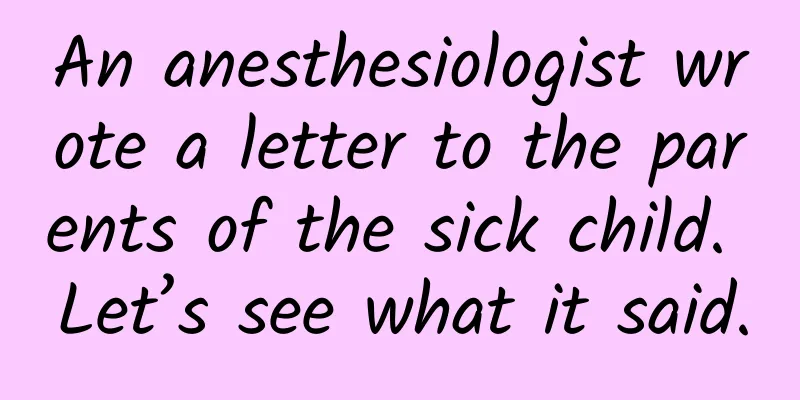An anesthesiologist wrote a letter to the parents of the sick child. Let’s see what it said.

|
From a medical perspective, there are huge psychological and physiological differences between children and adults, which poses a great challenge to pediatric anesthesiologists. We understand that every child is the apple of the eye and the sweetheart of the whole family, and all parents are often concerned about their children who are about to undergo surgery. But please believe that during the entire perioperative period, professional pediatric anesthesiologists will escort your child on your behalf like a family member, and are always ready to accept the dual challenges of safety requirements and comfort requirements. Preparation before anesthesia 1. Preoperative visit Anesthesiologists hope to have candid communication with parents during preoperative visits to understand the psychological and pathological state of the child and identify the child's difficult airway, cardiopulmonary insufficiency, and internal environment disorders. Some parents may conceal their children's cold symptoms during preoperative visits, which is very dangerous. Because upper respiratory tract infection is a contraindication to general anesthesia, children in the acute or recovery phase of inflammation have a higher sensitivity of the pharynx, and tracheal intubation and extubation are very likely to cause laryngeal spasm or bronchial spasm, endangering the child's life safety. If possible, please inform the anesthesiologist of the child's gestational age and post-gestational age, which will help the anesthesiologist more accurately assess the child's risk of postoperative apnea and avoid related complications. Parents will definitely worry that your children may have preoperative separation anxiety. Our pediatric anesthesiologists and nurses will work hard to establish a trusting relationship with the children, be the "most familiar people" to them during the operation, and strive to become the children's friends to help them relieve tension and anxiety. We will also provide preoperative education to the children in ways that are easy for children to accept, such as singing, playing games, and reading comics. 2. Fasting before surgery Parents may wonder why children are not allowed to eat or drink before surgery. This is because if there is food or water in the child's stomach before anesthesia, vomiting may occur easily during intubation and extubation. Vomitus containing acidic gastric juice may enter the lungs, causing tracheobronchial spasm and inducing chemical pneumonia, which is life-threatening in severe cases. Therefore, anesthesiologists generally require children who need general anesthesia to abstain from fried foods, greasy foods, and meat for 8 hours before surgery, to abstain from milk (excluding breast milk) and light diet for 6 hours before surgery, to abstain from breast milk for 4 hours before surgery, and to abstain from carbohydrate drinks and water for 2 hours before surgery. This is the most basic safety guarantee for anesthesia surgery! Commonly used methods of anesthesia in children 1. Induction of General Anesthesia Due to their unique anatomical and physiological characteristics, children are more susceptible to airway obstruction or respiratory depression during anesthesia. In addition, children have a short tolerance to hypoxia, which requires anesthesiologists to be quick, accurate, and steady when intubating the trachea. In addition, anesthesiologists will also use laryngeal masks instead of tracheal intubation tools to avoid major throat injuries. Inhalation anesthesia induction is a commonly used method of pediatric anesthesia induction. It has the advantages of rapid onset, relatively stable, painless, and easy to accept. Currently, commonly used inhalation anesthetics include sevoflurane, propofol, fentanyl, muscle relaxants, etc. The dosage of anesthetics used by children is different from that of adults. Pediatric anesthesiologists will accurately grasp the dosage of anesthetics to maintain the safety and comfort of children during the perioperative period. 2. Maintenance of general anesthesia During the entire anesthesia operation, the anesthesiologist will manage the child's ventilation through a ventilator. Among them, the smaller the child's weight, the greater the difference between the setting parameters of the tidal volume and respiratory rate and those of adults. During the operation, the child may have a need for fluid therapy. The anesthesiologist will calculate the intraoperative infusion volume based on the child's preoperative fasting time, physiological needs, fluid loss, third-interval loss, and blood loss, and supplement the child with isotonic fluid and blood products during the operation. In addition, the anesthesiologist will also conduct a full range of dynamic monitoring of the child during the operation, such as blood pressure monitoring, brain oxygen saturation monitoring, ECG monitoring, anesthesia depth monitoring, body temperature monitoring, etc., to help the child safely and comfortably get through the operation. In short, if the human body function is automatic driving at ordinary times, then during general anesthesia, it is equivalent to "manual driving mode", and the pediatric anesthesiologist is the "captain", regulating the various vital indicators of the child's body, just to escort them to complete the operation smoothly! 3. Local anesthesia In addition to general anesthesia, pediatric anesthesia also uses some local anesthesia methods, such as nerve block, epidural anesthesia, etc. When implementing local anesthesia, if the child cannot cooperate, the anesthesiologist will give them sedatives as appropriate to calm the child down and reduce fear. Anesthesia recovery management in children 1. Recovery delirium Under the protection of the pediatric anesthesiologist, the operation is successfully completed and your child will be sent back to the ward. At this time, the medical staff will closely monitor the child, because the child may become agitated or delirious during the awakening period, which may be caused by factors such as pain, throat discomfort and drugs. Parents do not need to worry, the medical staff will definitely give the child active and effective treatment and management. 2. Postoperative nausea and vomiting In addition, nausea and vomiting may occur after surgery. The reasons are many, such as the time of eating, the age of the child, the type of surgery, etc. It may also be related to the gastric inflation caused by mask ventilation. Parents do not need to worry about postoperative nausea and vomiting. The doctor will give the child antiemetic drugs to relieve the symptoms of postoperative nausea and vomiting and make the child more comfortable. 3. Throat gurgling During the postoperative recovery period, some children may experience "laryngeal sounds", indicating that the child may have laryngeal spasm or edema, which is a critical situation. At this time, medical staff will remain vigilant and ready to rescue at any time. 4. Pain For children, postoperative pain is also a common problem in the perioperative period. When leaving the operating room, the anesthesiologist will prepare a postoperative analgesia pump for the child to reduce or eliminate the acute pain caused by surgical trauma and help the child recover quickly. Dear parents, if your child is about to undergo or is undergoing general anesthesia surgery, please trust our medical staff. We will act as your child's "guardian angel" during the perioperative period on your behalf. Please also trust your children. They will be braver and stronger than you think. Children, parents and medical staff, let us redouble our efforts, overcome the difficulties together, become stronger together, and move towards the future together! Thanks to Rui Yan, the operating room nurse at Beijing Children's Hospital affiliated to Capital Medical University, National Children's Medical Center, for providing the hand-painted works |
Recommend
The benefits of eating flaxseed for women
Flax seeds contain two of the most important subs...
What is the perineum?
There are many acupoints on the human body, which...
Is it normal for pregnant women to have a slightly higher glucose tolerance for 2 hours?
Pregnant women can only give birth to healthy bab...
Is grapefruit sour or sweet? What kind of fruit is grapefruit?
Grapefruit contains valuable natural vitamin P, r...
What should I do if I have a stomachache during the holidays?
Many women nowadays do not pay attention to their...
How to treat hemorrhoids in girls?
Suffering from hemorrhoids has always been a thor...
Can a breast massager enlarge breasts?
Every woman wants her breasts to be fuller so tha...
What are the symptoms of uterine inflammation?
There are many kinds of gynecological diseases, c...
What should I do if I have vaginal itching?
Women may experience genital itching because they...
Crimson Hexagon: 250,000 users in the U.S. contracted the flu in December 2012
If you've had a cold in the past six weeks, b...
Black discharge during ovulation
There will be some vaginal discharge during the o...
What are the precautions for miscarriage during pregnancy?
In life, many women will encounter unexpected pre...
Sciatica after vaginal delivery
Many mothers will find that they have sciatic ner...
What vegetables and fruits are good for folic acid supplementation during pregnancy? Diet for folic acid supplementation during pregnancy
We all know that after a woman becomes pregnant, ...
Popular knowledge about family medicine
We call any substance that is used to treat, prev...









